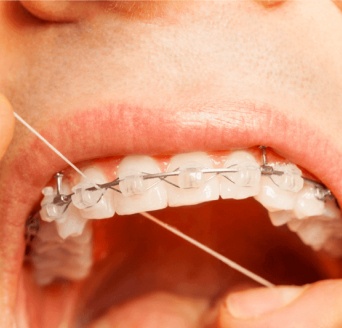
Flossing with braces may seem daunting at first, but we promise it’s not as bad as it looks. In fact, once you get the hang of it, it’s actually pretty easy!
In this guide, we will explore some of the best ways to floss with braces so that you can make the process as painless and easy as possible. From the best type of floss to use to how to floss correctly, read on for everything you need to know about flossing with braces.
How to Floss with Braces
If you have braces, you know that flossing can be a bit of a challenge. But it’s important to floss regularly, even with braces, to keep your teeth and gums healthy. So how do you floss with braces?
The easiest way to floss with braces is to use a floss threader. This is a small tool that looks like a needle with a loop at the end. You thread the floss through the loop and then carefully insert it under the wire of your braces. Once the floss is through, you can floss as normal.
If you don’t have a floss threader, you can still floss your teeth with braces using a string of waxed dental floss. Be sure to use waxed dental floss, since non-waxed floss can fray when rubbing against the wires.
Also, be careful not to snap the floss against your braces, as this can damage the wire. You’ll need to thread the floss around the braces by hand, which can be tricky but easy once you get the hang of it.
Floss each side of the tooth as normal, and repeat the process on each tooth. It may be time-consuming, but it is important to keep your gums healthy!
What Type of Floss is Best for Braces?
You should always use waxed dental floss when flossing with braces. The coating prevents it from fraying or tearing.
Waxed floss also makes it simpler to slip the floss between your teeth and have it glide smoothly against your teeth, keeping plaque out. For those with braces, waxed dental floss is always recommended.
There is also a type of floss made by Oral B called Super Floss. Oral-B Super Floss is specially designed for cleaning braces, bridges and wide gaps between teeth. Its three unique components—a stiffened-end dental floss threader, spongy floss and regular floss—all work together to provide maximum benefits.
How Can a Patient with Braces Make Flossing Easier?
The use of a floss threader can significantly reduce the amount of time needed to floss teeth for those who wear braces. Floss threaders are relatively inexpensive and can be found at most supermarkets or pharmacies. This small, plastic tool helps you pull floss behind the braces wire easily, and can save you several minutes in your dental care routine.
How to Use Properly a Floss Threader
Everyone has their own preference, but we will show you our favorite way to use a floss threader properly! It can help to tie the floss to the floss threader, so it doesn’t continually come out of the floss threader.
Once the floss is connected to the threader, slide the threader behind the braces starting on the gum side. This will stop you from poking your gums if you try to insert the floss threader from your mouth toward the gums. Once the floss is behind the braces, floss as normal between each tooth.
It might take some time to get used to it and take longer at first, but don’t worry! After flossing with a floss threader a few times, you will get used to it and move faster.
Conclusion
If you have braces, don’t worry – flossing is still possible! We hope this article gives you a better understanding of how to floss with braces, and we’re happy to help you figure out the best method for you. Give us a call today at Bluebird Orthodontics and we’ll be happy to help you keep your smile healthy and sparkling!
